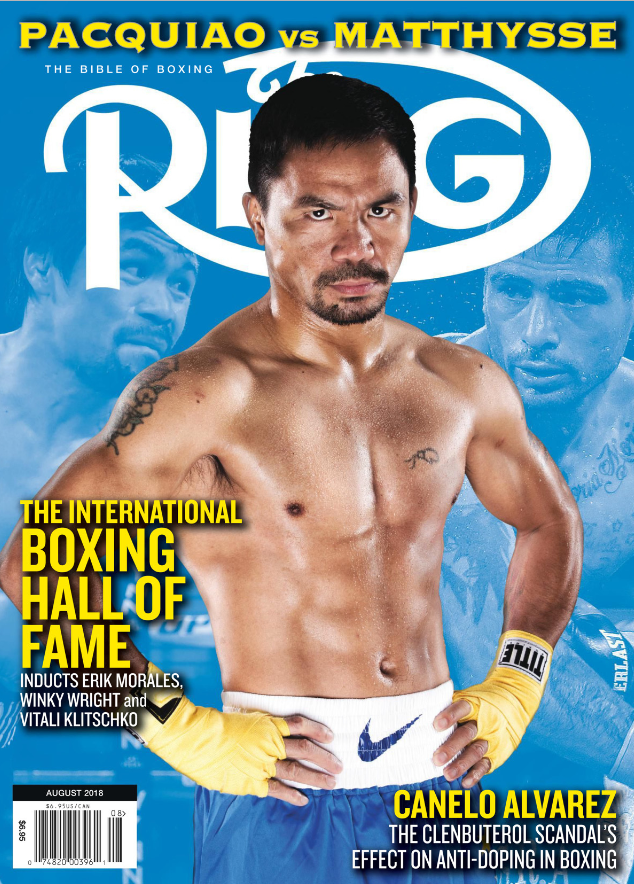The Travelin’ Man returns to Sloan, Iowa: Part two

Please click here to read Part One.
Friday, July 20 (continued): Jaron Ennis entered the ring in Sloan, Iowa, with a lot to prove. Not only was he attempting to show there was substance behind his glossy record (20-0, 18 knockouts), he was also vying to break the family’s “ShoBox” jinx. As mentioned in Part One, older brothers Derek (TKO by 2, Allen Conyers in 2007) and Farah (L UD 10, Badou Jack in 2013) had lost on ShoBox cards, and Jaron, though honored to be the third Ennis boxer to appear on the series, was determined to forge new ground – and do so impressively.
That he did, as “Boots” stomped the previously undefeated Armando Alvarez, who was floored four times in round three before the fight was stopped. As compelling as the knockdowns were, the versatility Ennis exhibited was even more so: A left to the jaw on knockdown No. 1, a left to the pit of the stomach that produced a delayed reaction on knockdown No. 2, a jab-right uppercut-left hook on knockdown No. 3 and a volley capped by a right uppercut to the jaw to prompt the stoppage.
The CompuBox numbers further illustrated the fight’s lopsidedness – 72-20 in total connects and 65-17 in landed power shots, as well as percentage gaps of 37%-13% overall, 13%-7% jabs and 46%-16% power. Additionally Ennis beat Alvarez at his own game. In stating his pre-fight strategy, Alvarez, though taller and longer-armed than Ennis, repeatedly said he would attack the body at every opportunity. Though Alvarez tried, Ennis succeeded, as he led 35-8 in body connects. Somewhere Joe Frazier must have been smiling.
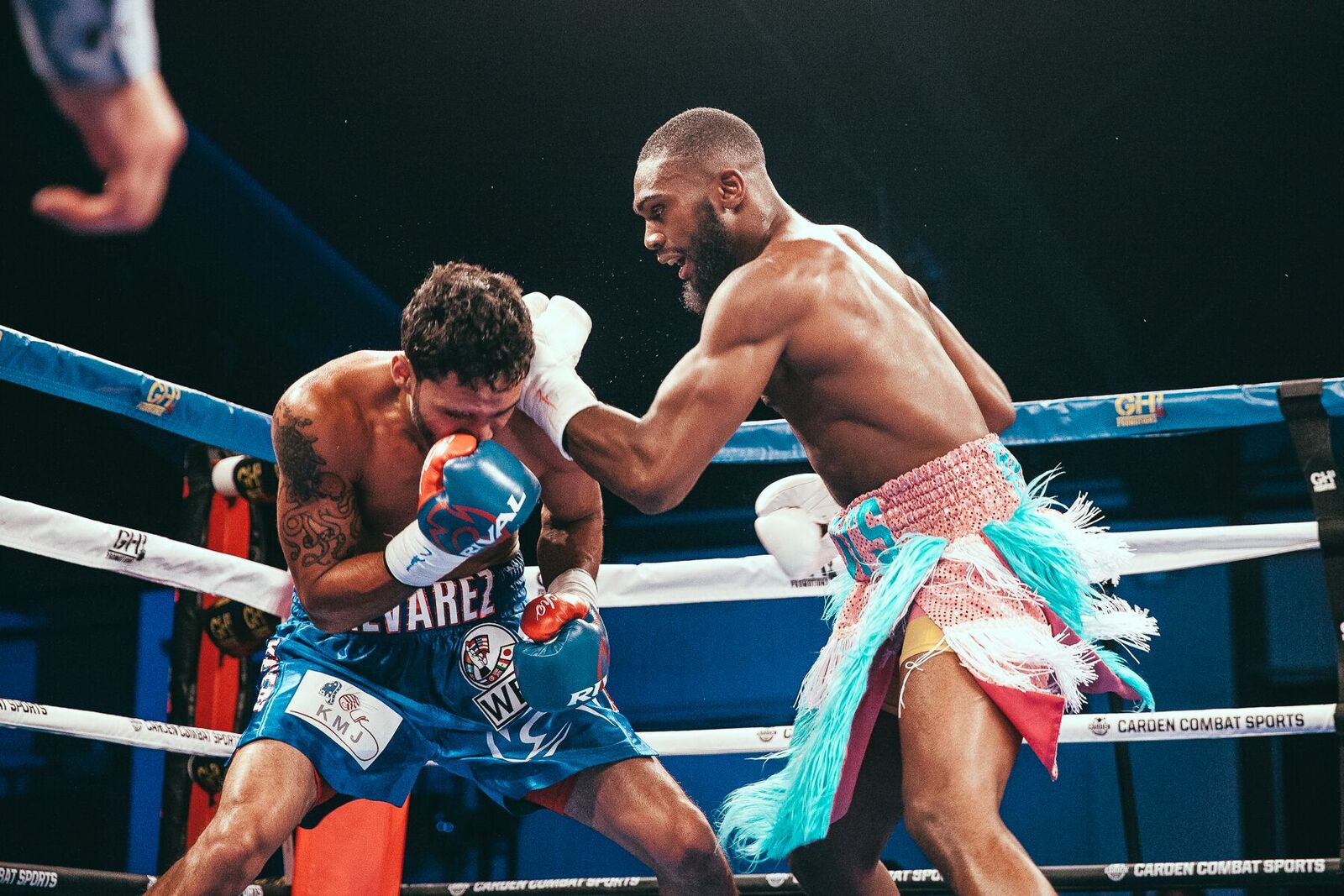
Welterweight Jaron Ennis (right) vs. Armando Alvarez. Photo credit: Rosie Cohe/Showtime
After using the first round to assess his opponent, Ennis dispensed with the jab in rounds two and three (he threw just 25 and landed two in that span), and focused on demolishing the Floridian with his hooks, crosses and uppercuts. Two significant moments that helped set up the finish occurred in round two. The first happened a minute into the session when Alvarez, who had Ennis pinned to the ropes, connected with a scything right uppercut to Ennis’ jaw, the final punch of a three-punch volley. It was the best punch Alvarez had landed, to this point, but not only did Ennis take it well, he instantly retaliated with two blows (both of which missed), spun off the ropes and resumed his body attack. The second happened in the round’s closing moments: After slipping under an Alvarez right and smartly pivoting to his own right, he looked toward his corner with both hands at his side. Alvarez, surprised Ennis would give him such an open target, hesitated for a couple of seconds before setting himself to throw a right. As a subsequent replay would show, Ennis was simply presenting an illusion; he was watching Alvarez out of the corner of his eye all along, and darted away the instant Alvarez moved his left glove to set up the right hand. With a satisfied smile on his face, Ennis then landed a light left cross to the face, stuck out his own face, while crouching in front of Alvarez, and landed another long left to the mouth before clamping on a round-finishing clinch.
By taking Alvarez’s strongest punch without flinching and by showing the Floridian he could still be the better fighter, even after a showboat move, Ennis established an unshakable physical and mental superiority that Alvarez couldn’t overcome. The fruits of that superiority began with the first knockdown of round three, which happened 23 seconds into the round, and ended with the fourth, which prompted the stoppage with one second left.
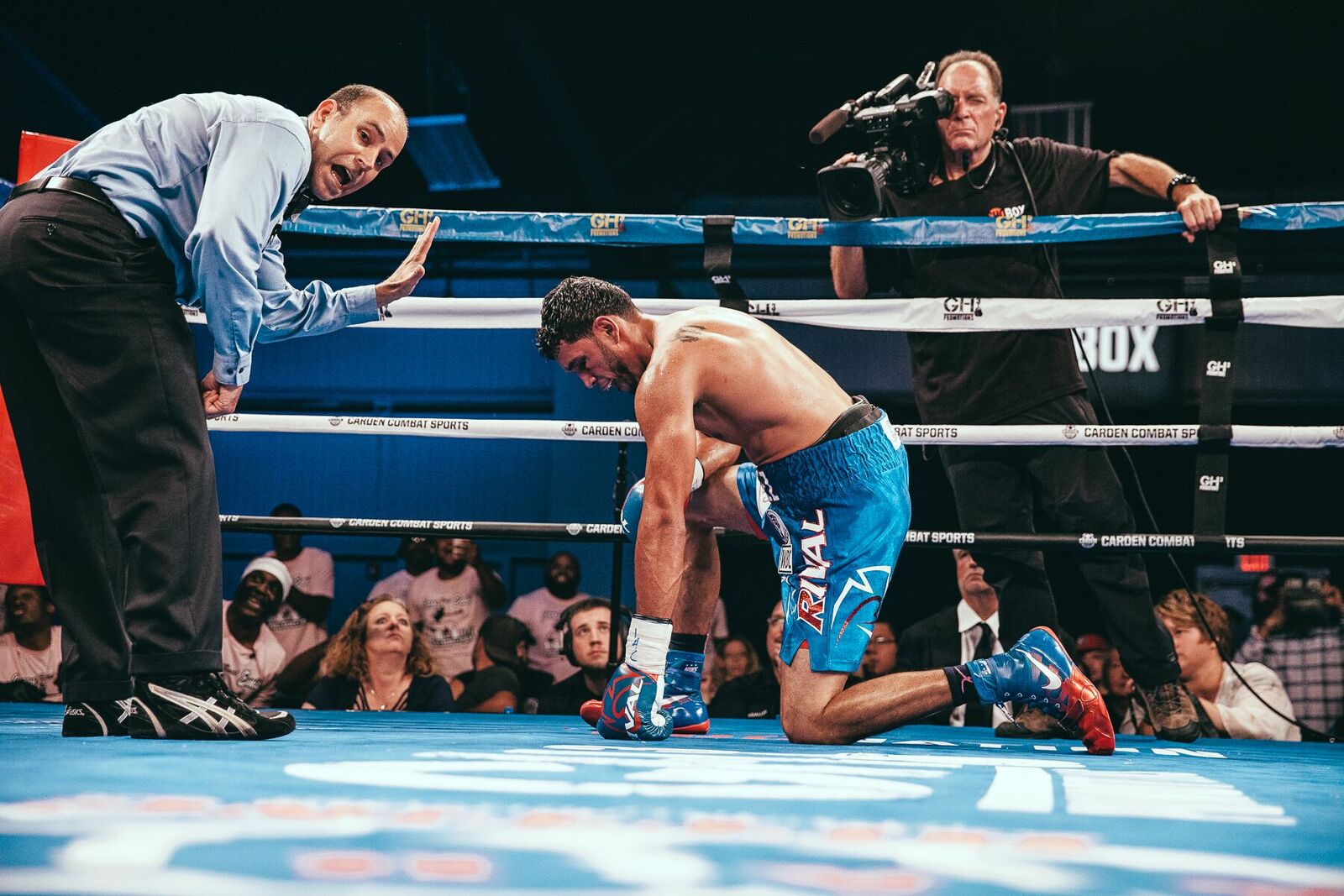
Welterweight Armando Alvarez. Photo credit: Rosie Cohe/Showtime
Ennis said before the fight that he wanted to put on a show for the ShoBox audience, while also fighting for the honor of his family, and the legacy of his hometown of Philadelphia. While “two out of three ain’t bad,” according to the singer Meat Loaf, Ennis showed three out of three is even better.
*
Hall of Fame blow-by-blow man Barry Tompkins called it “absolutely criminal,” not once but twice. His Hall of Fame colleague Steve Farhood called it the worst decision he had seen in his 17 years of calling fights on the ShoBox series. And to almost everyone not named Jeff Sinnett and Mike Contreras, Thomas Mattice’s split decision over Zhora Hamazaryan was a miscarriage of fistic justice. While colleague Bob LaFratte saw Hamazaryan a 77-74 winner, Sinnett and Contreras turned in 76-75 scores for Mattice, who was dropped in round two from a whistling right to the jaw, to account for the bout’s only knockdown, and who appeared to be dominated in the final three rounds.
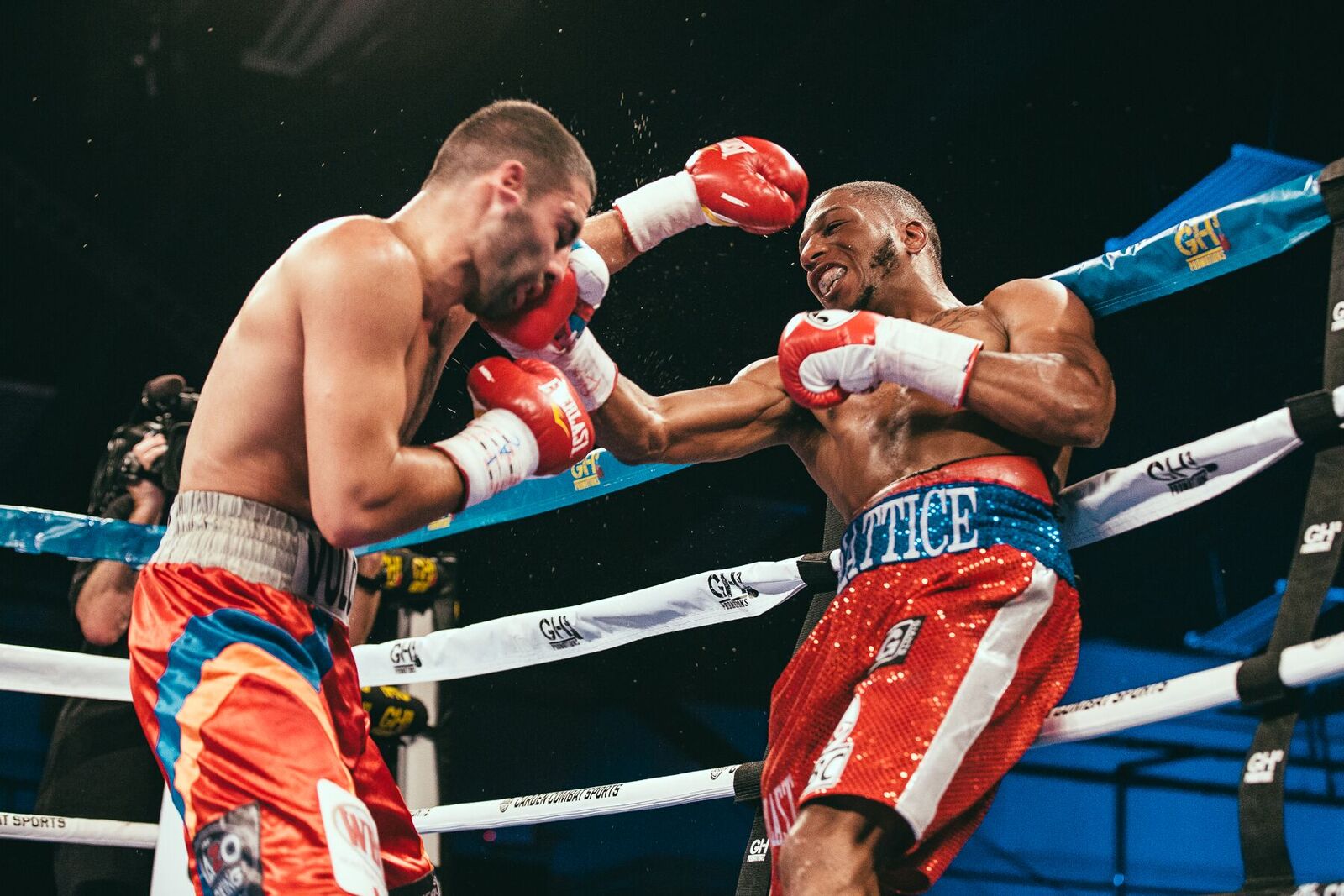
Lightweight Thomas Mattice (right) vs. Zhora Hamazaryan. Photo credit: Rosie Cohe/Showtime
As is usually the case with CompuBox, the numbers backed up the conventional wisdom regarding a controversial decision. Hamazaryan threw more (499 to 393), landed more (134-97 overall), connected with more power punches (100-57) and, in a clear demonstration of ring generalship (one of the four judging criteria), effectively neutralized Mattice’s best weapon, the jab (Mattice led just 40-34 in landed jabs, and actually trailed Hamazaryan 22%-19% in jab accuracy). Because fights are judged round-by-round – and because the fighter who lands more punches in a given round usually goes on to win it – it is useful to note Hamazaryan out-landed Mattice 5-2-1 in total connects, thanks to sweeping the final three rounds (17-10 in the sixth, 18-13 in the seventh and 22-14 in the eighth). That 57-33 bulge in overall punches, in addition to his 34-25 lead in landed power punches, and the fact that he nearly dropped Mattice again with a right in the seventh, helped Hamazaryan make his case that he won the fight. That he didn’t is astonishing.
In the eyes of Sinnett and Contreras, the margin of victory occurred in rounds three through six, all of which they gave Mattice. When matched up against the stats, it is conceivable that Mattice might have won the third (where he led 18-15) and the fifth (where they each landed 16 punches) but it’s hard to fathom how they could have awarded him the fourth and sixth, where Hamazaryan prevailed 22-14 and 17-10 in total connects. One way to justify giving Mattice such rounds would be if one of his connects either dropped or significantly shook Hamazaryan, neither of which happened. Two main judging pillars is “effective aggressiveness” and “clean punching,” so if a fighter is coming forward, and if he’s landing more frequently, as well as with more force, he should be given the round. That happened inside the ring in rounds four and six but not on the scorecards of Sinnett and Contreras.
Will the two judges in question be asked to justify their scorecards by Joe Walsh, the executive director of the Iowa Athletic Commission? Will the result be reversed upon further review? History says no – if the first Lennox Lewis-Evander Holyfield fight wasn’t reversed, why would this one? – so the most likely way to resolve this issue is to stage a rematch with a more seasoned panel of judges.
*
I also didn’t agree with the draw rendered in the opening fight of the telecast – the draw between Montana Love and Kenneth Sims Jr. – but the outrage over the Mattice-Hamazaryan verdict overshadowed a fight I believed Sims deserved to win because he did a better job of pacing himself throughout the bout, while also out-landing Love in the vast majority of rounds.
Love himself noted Sims’ pacing struggles, during his pre-fight interview, when he correctly stated that Sims gassed out after two-and-a-half rounds. The evidence: In his five previous CompuBox-tracked fights, Sims averaged 86.5 punches per round in the first six minutes, while dipping to 63.3 in rounds 3-5. Here Sims again produced a blazing start – 90 punches and leads of 30-13 overall and 27-11 power, and, in rounds two and three, his work rate did dip to 66 and 58 punches. However despite being aware of the trend, Love failed to take advantage. That, to me, was his fatal flaw. In round two Love threw 38 punches, and was out-landed 18-7, while, in the third, he fired only 41 and was out-connected 16-9. Sims then perked up in round four (in which he went 30 of 74 to Love’s 17 of 69), while in round five, Love finally out-threw and out-landed Sims for the only time in the fight (21 of 65 to Sims’ 13 of 51).
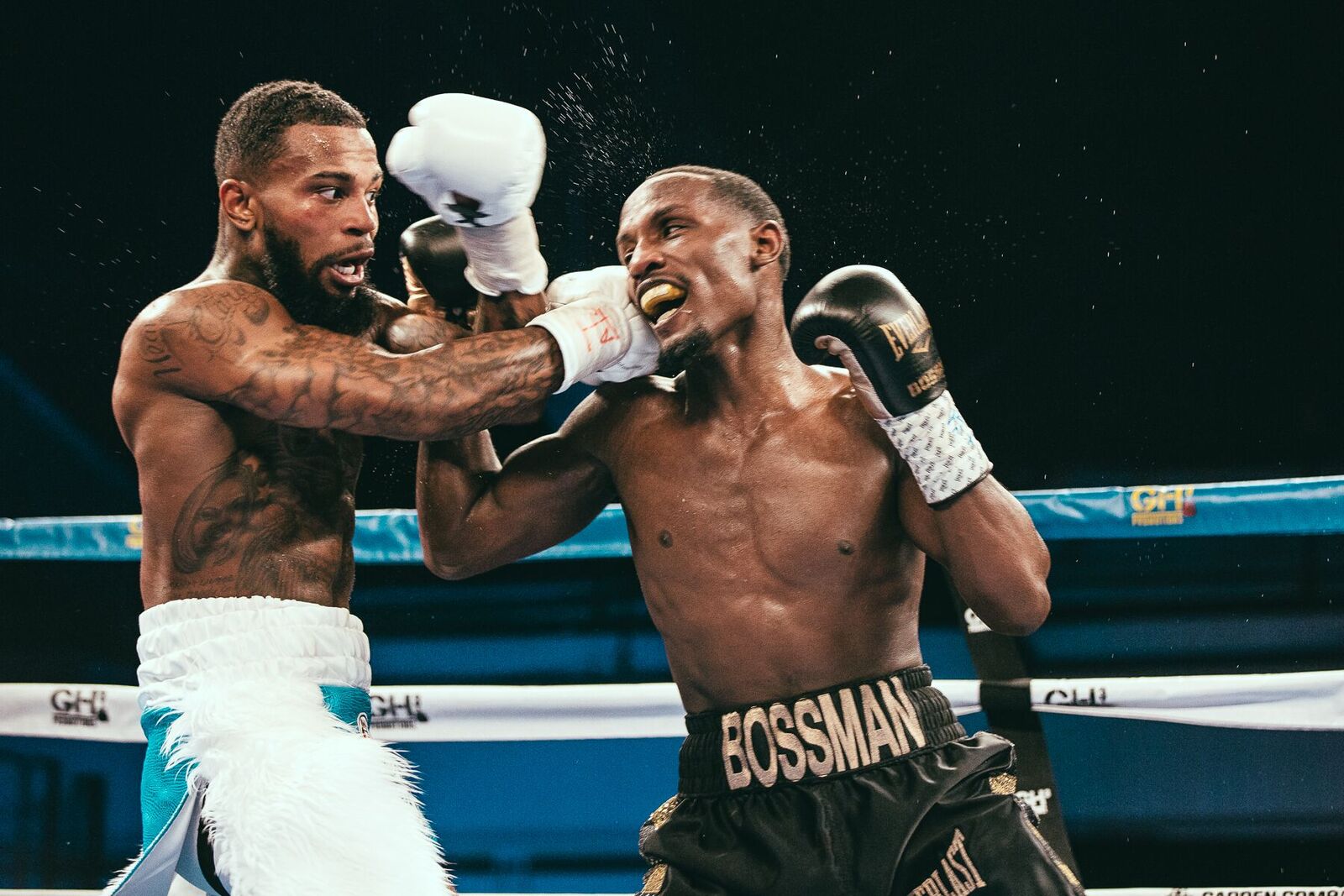
Junior welterweight Montana Love (left) vs. Kenneth Sims Jr. Photo credit: Rosie Cohe/Showtime
The other significant trend in Sims’ statistical profile is that he managed to summon a strong second wind in rounds six through eight, in which he had thrown 86.7 per round in his previous bouts. Against Love, the surge was even stronger, as he went from 51 in the fifth to 75 in the sixth, after which he throttled up to 108 and 116 in the final six minutes. Love, too, escalated his output from 65 in the fifth to 77, 86 and 96 in the final three rounds. Better yet for Sims, he out-landed Love 104-92 overall and 95-83 power in the final nine minutes, which allowed Sims to create final leads of 211-159 overall, 33-27 jabs and 178-132 power. Additionally Sims led 33%-30% in overall accuracy and 23%-14% in jab precision. However Love landed a higher percentage of power punches (39%-36%), and he out-landed Sims 41-38 in the final round.
The round-by-round breakdowns revealed Sims out-landed Love in six of the eight rounds, including each of the first four and two of the last three. Also Love said, during the pre-fight interview, he wanted to produce the better body attack but Sims led 84-60 in that department. Finally as was the case with Mattice against Hamazaryan, Love was unable to keep Sims at arm’s length with his jab; in fact Sims landed more of his jabs (33-27), despite throwing fewer of them (143 vs. 192).
Therefore while Hamazaryan deserved much better from the judges than what he received, I was disappointed that Sims’ better work wasn’t rewarded more. For the record, Sinnett scored the fight 77-75 for Sims while LaFratte scored it a draw and Contreras saw it 77-75 for Love.
By the way, my prediction of 20 rounds for the telecast came one second short of coming true, for the main event ended at 2:59 of round three, while the two other fights went the full eight.
*
I drove Andy back to the crew hotel, then spent 40 minutes inputting the night’s numbers into the master database. It took me a while to settle down enough to turn out the light, and, as I did, I hoped I would stuff in enough rest to feel energized to make the long trip home.
Saturday, July 21: Those hopes didn’t come to pass. A nightmare jolted me awake at 4:45 a.m., and my attempt to resume my slumber failed because of the sounds my smart phone made after receiving a sudden flurry of emails. Because those emails required research to answer – and because I couldn’t get back to sleep after investing the brain power – I decided to officially begin my day. The early start was a blessing in disguise because I now had the time to finish writing Part One, while also getting a small jump on Part Two. Because my flight from Omaha to Charlotte was set to leave at 11:52 a.m. – and because I wanted to give myself enough time to fill the rental car’s tank and arrive at the airport without having to rush – I left the hotel at 8:15 a.m.
I couldn’t have asked for better driving conditions – a sun-drenched 72 degrees. Traffic was also light and well-behaved, no tailgating, honking horns or other distractions. Google Maps seamlessly guided me to the Omaha airport property but I had to shut it down when the signage for the rental car garage conflicted with my phone’s order to “make a U-turn.”
Once I returned the rental car (a white Toyota Camry), I walked to a Blimpie’s outlet and ordered a sub, chips and a medium diet soda. I checked the clock – 10:15 a.m., 67 minutes before my scheduled boarding. With TSA Pre-Check, I ate at a leisurely pace, while reading the Tiger Woods biography I brought with me. Little did I know that, on this day, Tiger would, at least for a while, sit atop the leader board at The Open Championship. He was just seven holes away from his first major victory in a decade, and the 15th of his career. Alas a double-bogey at 11 and a bogey at 12 ended that dream but his fifth-place finish was his first Top-10 at a major since the 2013 Open.
As is the case with legendary boxers who compete into their 40s, the sustained brilliance that defined the 42-year-old Woods’ prime now only came in flashes, and those flashes weren’t enough to secure victory over his younger and fresher competitors. That said, the only damage sustained to Tiger after failing to complete his task was to his considerable competitive pride; for boxers, the toll is far more severe – and much longer lasting.
With the meal done and the Tiger book safely in my laptop bag, I headed for the security checkpoint. While passing underneath the metal detector reserved for Pre-Check passengers, its alarm went off.
“Don’t worry; you’ve just been randomly selected,” the polite female TSA agent said. “It’s nothing you did. Just back up and go through again.” I did, and, this time, the detector remained quiet. But I did have to have the oil from my hands swabbed and analyzed, which passed muster.
On almost every trip, I experience a nice coincidence, and my delay at the security checkpoint set the stage for this instance. Immediately after passing through security, I spotted two Chinese men wearing gray sweat suits walking to my left. I immediately recognized them: heavyweight Zhang Zhilei and light heavyweight Meng Fanlong. I also recognized their trainer’s face but couldn’t place the name.
“Your guys fought great last night,” I said to the trainer.
“Thanks,” he replied.
“I worked the fight card last night, as one of the punch counters,” I said before telling him my name.
“Great to meet you,” he said. “My name is Shaun…Shaun George,” he replied.
At that, my mind immediately went back to May 16, 2008, and Las Vegas’ Thomas & Mack Center, where I worked an ESPN show using the network’s “Punch Track” system. George was cast as the B-side of former IBF heavyweight champion Chris Byrd’s first fight at light heavyweight since his second pro outing 15 years and one day earlier. George spoiled the desired story line by dropping Byrd in the first, and scoring two more in the ninth, before referee Jay Nady wisely stopped the lopsided bout. While Byrd went on to fight one more time (a fourth round TKO over Matthias Sandow in a cruiserweight bout staged in Stuttgart), George, only 29 at the time of the Byrd victory, fought just twice before retiring (TKO 1 over Jaffa Ballogou in New York and a TKO by 6 versus Chris Henry in Philadelphia in July 2009).
George, who remains youthful and trim, smiled when I brought up the Byrd fight, and the fact that I had been there to witness it. He then introduced me to the 6-foot-6 Zhang, who shook my hand. Had I not been held up at the security line, I might not have had the chance to chat with George.
I arrived at my gate with 32 minutes to spare, and my flight to Omaha was completed without incident. However moments after landing, I checked my email and saw that HBO needed me to compile information on the judges for tonight’s doubleheader (Alberto Machado-Raphael Mensah/Jaime Munguia-Liam Smith). I had a 40-minute window between my arrival at the gate and the start of boarding for my Pittsburgh flight, and, while I successfully finished the task, I cut it quite close. Moments after confirming with CompuBox President Bob Canobbio that the research had been received, I saw that the boarding process had already started. The good news was that passengers in Group 4 were being admitted, and I was in Group 6. Less than five minutes later, I was sitting in seat 13C.
Because of paperwork issues, the plane didn’t leave Charlotte until 5:25 – 40 minutes later than scheduled. Still, the plane arrived in Pittsburgh at 6:25, just five minutes later than advertised, and by 6:55, I was in my car and ready to begin the long drive home.
That drive ended shortly before 9:30 p.m., and I spent the remainder of the evening watching the HBO show, which saw a markedly improved Machado impressively outpoint Mensah and Munguia score a pulsating decision over rugged ex-titlist Liam Smith. Had Munguia lost, his 70-day WBO junio middleweight title reign would have been the shortest span in 154-pound championship history, in which a fighter won and lost his belt inside the ring. Because Munguia won, Lupe Aquino’s 82-day reign remains the briefest such reign on record.
While Sloan, Iowa is the smallest town, in terms of population to host a Showtime telecast (973), my next destination – Los Angeles – is one of the largest, at nearly 4 million. There at the Staples Center, WBC lightweight titlist Mikey Garcia and IBF counterpart Robert Easter Jr. will engage in a unification bout, while heavyweight Luis Ortiz will attempt to bounce back from his 10th round TKO loss to WBC champion Deontay Wilder, at the expense of Romanian Razvan Cojanu. The third bout on the televised portion will pit undefeated junior welterweight Mario Barrios against Jose Roman, who is coming off a 10-month layoff, as well as an upset decision loss to Wilberth Lopez. My journey will begin less than six days from now.
Until then, happy trails!
*
Lee Groves is a boxing writer and historian based in Friendly, West Virginia. He is a full member of the BWAA, from which he has won 16 writing awards, including two first-place awards, since 2011. He has been an elector for the International Boxing Hall of Fame since 2001 and is also a writer, researcher and punch-counter for CompuBox, Inc. He is the author of “Tales from the Vault: A Celebration of 100 Boxing Closet Classics” (available on Amazon) and the co-author of the newly released book “Muhammad Ali: By the Numbers” (also available on Amazon). To contact Groves about a personalized autographed copy, use the email [email protected] or send him a message via Facebook.
Struggling to locate a copy of THE RING Magazine? Try here or
Subscribe
You can order the current issue, which is on newsstands, or back issues from our subscribe page.



